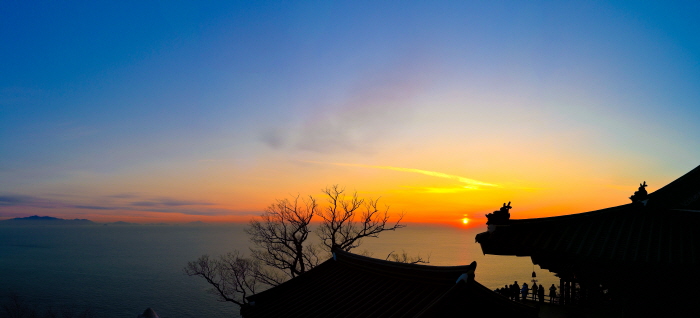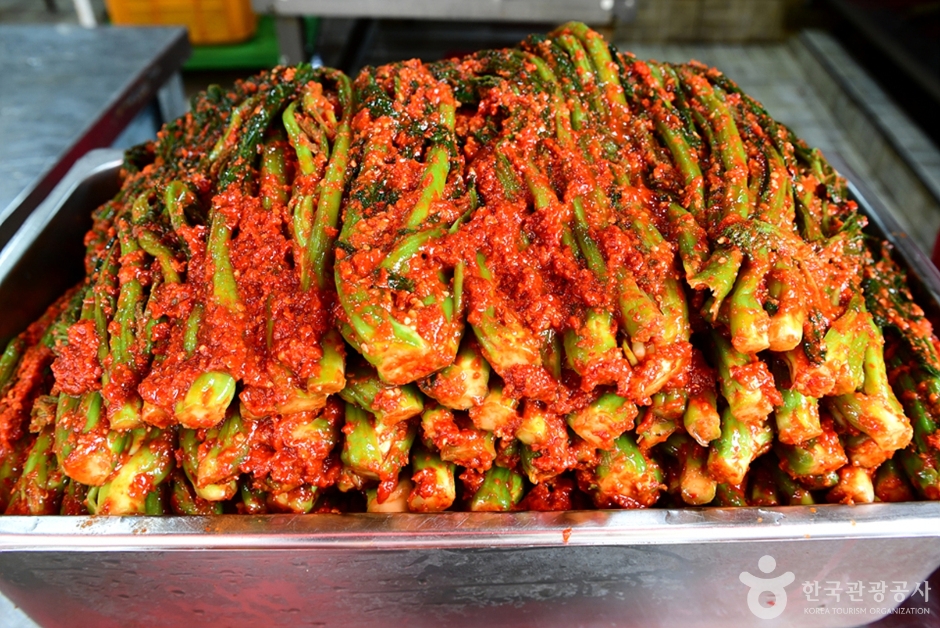Mijo Restaurant (미조식당)
19.0 Km 21040 2024-02-26
232 Mijo-ro, Mijo-myeon, Namhae-gun, Gyeongsangnam-do
Mijo Restaurant, a dedicated anchovy restaurant located in Namhae German Village, specializes in myeolchi hoe (sliced raw anchovy). This dish is crafted with freshly caught anchovies from Namhae, delicately seasoned with homemade chojang (red chili paste with vinegar). Complementing this are menu items such as galchi jorim (braised cutlassfish) and myeolchi twigim (deep-fried anchovies). The assortment of fresh seafood side dishes varies with the seasons, enhancing the overall dining experience for visitors.
Seolcheon Namhae Coastal Road (설천 남해해안도로)
19.1 Km 0 2024-02-23
Seolcheon-myeon, Namhae-gun, Gyeongsangnam-do
Seolcheon Namhae Coastal Road, spanning 35 kilometers, connects Noryang in Seolcheon-myeon to Jijok in Samdong-myeon in Namhae. Celebrated for its scenic beauty, this route is particularly enchanting in spring, adorned with cherry blossoms and mustard flowers. The journey unfolds against the backdrop of the stunning natural landscapes of the Hallyeosudo along the coast. Moreover, it offers an opportunity to explore other attractions in Namhae, including the Bijarim Forest and the Namhaedaegyo Bridge.
Yeosu Hanok Experience Center [Korea Quality] / 여수한옥체험관 [한국관광 품질인증]
19.4 Km 26 2023-10-26
47 , Sanggwan-gil, Yeosu-si, Jeollanam-do
+82-61-682-5057
Yeosu Hanok Experience Center is part of Sanggwan Village, Yeosu City, and can be rented as a single guesthouse. Accomodation consists of a bed room, two ondol rooms, a living room, and two bathrooms, and provides a healthy rest with a Gudeuljang and a red clay wall. There is a kitchen, and a barbecue area outside (charcoal and grill provided free of charge). By prior arrangement, a free pickup service from Yeosu Airport or Yeosu Bus Terminal is available. Guests can experience tradtional games such as Yutnori and Neolttwigi and crafts such as Injeolmi rice-cake making.
Yeosu Hyangiram Sunrise Festival (여수 향일암일출제)
19.7 Km 11760 2022-12-14
70-4, Hyangiram-ro, Yeosu-si, Jeollanam-do
• 1330 Travel Hotline: +82-2-1330 (Korean, English, Japanese, Chinese) • For more info: +82-61-659-4743, +82-1899-2012
Hyangiram Sunrise Festival is an annual overnight festival that begins on New Year's Eve. It takes place at the historic Hyangiram Hermitage, which was built in the year 644. As the New Year's Day dawns, visitors can witness the sun rise above the horizon from Hyangiram, which literally means "a hermitage facing the sun."
Kim Miyoung Dolsan Gatkimchi (김미영 돌산갓김치)
19.7 Km 0 2024-02-21
57 Hyangiram-ro, Dolsan-eup, Yeosu-si, Jeollanam-do
Kim Miyoung Dolsan Gatkimchi is a specialty packaging store located below Hyangiram Temple in Geumosan Mountain. When you order Dolsan gatkimchi (Dolsan leaf mustard kimchi), they mix the leaf mustard and pre-marinated seasoning on the spot before packaging. Dolsan leaf mustard, a specialty of Yeosu, grows in the warm marine climate with rich soil and sea breeze, resulting in its tender leaves and distinctive flavor.
Jodo Island (조도)
19.8 Km 4281 2024-02-23
5-10 Jodo-gil, Mijo-myeon, Namhae-gun, Gyeongsangnam-do
Jodo Island, located just off the coast of Mijo Port, is renowned as Saeseom Island (Bird Island) due to its distinctive bird-like shape when viewed from above. From a distance, it appears as two distinct islands; the larger one, home to the village, is known as Keunseom Island, while the smaller is called Jodo Island. A trail connecting the two islands offers an opportunity to marvel at an array of uniquely shaped rock formations.
Yeosu Hyangiram Hermitage (향일암(여수))
20.0 Km 38783 2022-12-28
60, Hyangiram-ro, Yeosu-si, Jeollanam-do
+82-61-644-4742
Hyangiram Hermitage (Cultural Property Material) is one of four Buddhist hermitages in Korea where the faithful come to pray to the Avalokitesvara Bodhisattva. It was originally named Wontongam Hermitage, established by Monk Wonhyo during the fourth year of Baekje King Uija’s reign (644). Wontongam Hermiatge was renamed to Geumoam Hermitage by Monk Yunpil in the 9th year of Goryeo King Gwangjong’s reign (958), then renamed once again to Hyangiram Hermitage by Monk Inmuk during the 41st year of Joseon King Sukjong’s reign (1715).
The temple contains many buildings both preserved and rebuilt, including the main hall, Daeungjeon Hall, which was rebuilt in 2012 after it burned down in a fire. The mountain path to Hyangiram Hermitage is very steep, but many people make the climb in hopes of their wish coming true. Legend has it that anyone who passes all seven of the stone caves on the walk to Hyangiram Hermitage will be granted their wish.

![Yeosu Hanok Experience Center [Korea Quality] / 여수한옥체험관 [한국관광 품질인증]](http://tong.visitkorea.or.kr/cms/resource/04/3021504_image2_1.jpg)


 English
English
 한국어
한국어 日本語
日本語 中文(简体)
中文(简体) Deutsch
Deutsch Français
Français Español
Español Русский
Русский